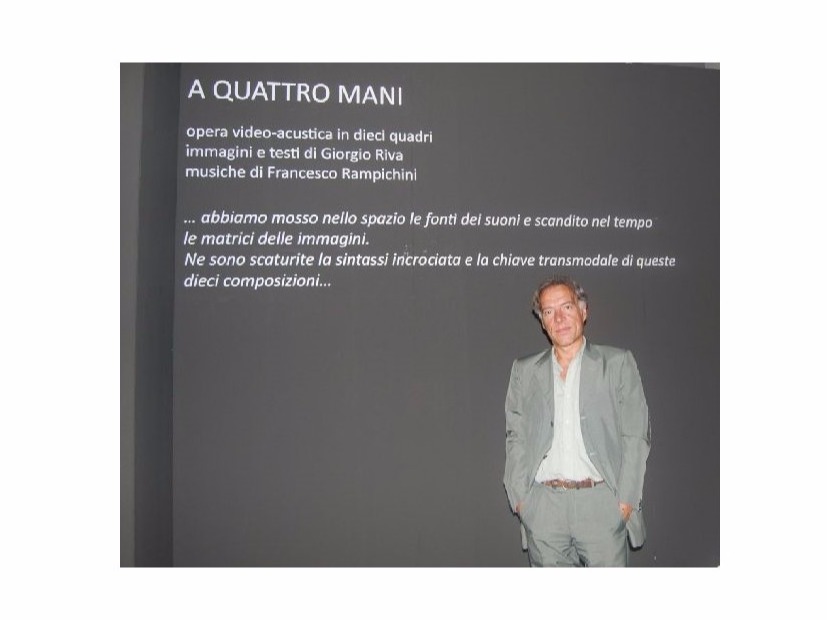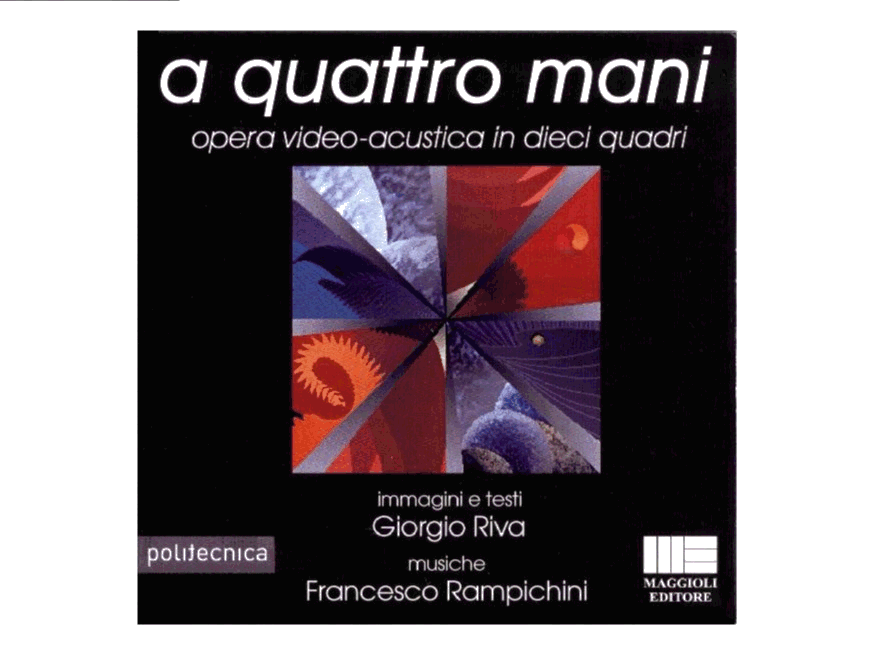Collana "Politecnica-Arte" (ed. Maggioli)
A QUATTRO MANI - Opera video acustica in dieci quadri
Giorgio Riva, Francesco Rampichini
Disponibile presso: Feltrinelli | Hoepli
QUADRI
1. Eclissi nell'occhio di Omero / Eclipse in the Homer eye
2. Orfeo / Orpheus
3. Canoni a perno eccentrico / Canons with eccentric pin
4. Témnon
5. Yin Yang
6. Nottola di Minerva / Owl of Minerva
7. Nel giardino di Braque / In the garden of Braque
8. Dicotide
9. Fanete / Phanetes
10. Eos
(N.B. Link temporaneamente disattivati in attesa delle versioni ad alta definizione in corso di lavorazione.
Links temporarily disabled waiting for the high definition versions in progress.)
L’Opera
Giorgio Riva e Francesco Rampichini si incontrano nel 1998 al Politecnico di Milano dove svolgono corsi come docenti incaricati. Hanno così modo di scambiarsi conoscenze teoriche e di discutere criticamente i rispettivi itinerari. Nel 2004 decidono di incrociare anche le loro esperienze creative e lo fanno a partire da un CD (G. Riva, Infoplasma, metamorfosi delle immagini, Milano 2000), che il pittore offre al musicista come canovaccio di immagini silenziose - ma già ritmiche - per un’opera da comporre in chiave pittorico-musicale.
A quattro mani origina da due linee di ricerca che per diversi anni hanno avuto svolgimenti separati, senza che gli autori sapessero di certi loro intenti comuni:
“abbiamo scoperto con sorpresa che da tempo stavamo componendo con linguaggi tecnicamente coniugabili: le immagini metamorfiche scaturivano da matrici informatiche programmate per scandire forme tanto nello spazio, quanto nel tempo; le musiche acusmetriche uscivano da fonti capaci di muoversi nello spazio in sequenze temporali.”
Per entrambi, dunque, il concetto di sequenza aveva assunto una valenza spaziale oltre che temporale. E così quello di “ritmo” e pure quello di “prosodia”.
Ma quando i suoni vengono agitati nello spazio e le immagini vengono scandite nel tempo, i tradizionali confini tra musica e pittura si disfano; e se la musica vuole aderire a ritmi e forme della pittura può fare immagini acustiche che consuonano con quelle visive. Del pari, l’immagine metamorfica può assumere movenze aderenti a flessi, salti e pause dei suoni. Si sarebbero così individuate coppie di segni isomorfi, dotate di due “significanti” e di nessun “significato”? Forse. Tuttavia, questi duplici segni non appaiono privi di senso. E neppure privi di nessi con i temi e gli etimi delle parole che occhieggiano dai titoli: “Da lontano, sull’orizzonte, abbiamo voluto che si affacciasse, con la parola, anche il volto effabile delle nostre immagini.”
Isomorfismo, aderenza e consonanza, hanno occupato una fase di ricerca segnica lunga e, secondo gli stessi autori, persino ossessiva. Ma vista e udito, grazie al loro potere di risintetizzare senso in ciò che si “video-ascolta”, riaprono la via per abbinare o disgiungere, sincronizzare o alternare: se il pittore lo provoca, il musicista può rispondere o sottrarsi. E se la dialettica include anche il silenzio, “certe nostre reciproche assenze o fughe nei silenzi o nei bui ambiscono a toccare, attraverso lo scherzo, anche le corde dell’ironia e del sarcasmo.
Il percorso ha richiesto conoscenza critica dei codici informatici e strumentazione tecnica di prim’ordine. Si chiama GIOMAX-DIACRON l’ultima versione del software che Riva, assieme all’ingegnere informatico Massimo Bordoli, ha concepito e messo a punto per realizzare A quattro mani. Nessun altro software in commercio è risultato sufficiente.
Approfondimenti
MiBACT - A quattro mani
Museo della Permanente
Museo 3 tetti (a quattro mani)
Video suite
Exibart
Dépliant 2005

Exhibition at the art gallery Permanente ("Omaggio a Giorgio Riva", Milano 2014).
A QUATTRO MANI - Video acoustic work in ten pictures
Giorgio Riva, Francesco Rampichini
Available at: Feltrinelli
The Work
Giorgio Riva and Francesco Rampichini met each other in 1998 at the Polytechnic of Milan, where both carry out courses as professors in charge. So they have the opportunity to exchange theoretical acquaintances and to discuss about their respective routes. In 2004 they decide also to cross their creative experiences, starting with a CD (G. Riva, Infoplasma, metamorfosi delle immagini, Milano 2000), that the painter offers to the musician as a plot of silent – but already rhythmic – images, for a work to be composed in a pictorial-musical key.
A quattro mani originates from two research lines that for several years had separate courses, the authors not knowing about some common aims:
“We found out with surprise that for a long time we were composing with technically conjugable languages: the metamorphic images gushed from informatic matrices, programmed to scan shapes in space as in time; the acousmetric musics came out from sources able to move in space within time sequences.”
For both, therefore, the concept of sequence had a spatial, besides a temporal, meaning. And so the meaning of “rhythm” and also that of “prosody”.
But when sounds are moved in space, and images are scanned in time, the traditional boundaries between music and painting disappear; and if music wants to adhere to paint’s rhythms and shapes, it can create acoustic images consonant with the visual ones. In the same way, the metamorphic image can take on movements adherent to sound flexions, jumps and pauses. Would thus be identified pairs of isomorphic signs, with two signifiers and no meaning? Perhaps.
However, these double signs does not appear devoid of sense. And not even deprived of nexuses with the themes and the etymons of the words that ogle from titles: “from a distance, on the horizon, we wanted that leaned out, with the word, also the effable face of our images.”
Isomorphism, adhesion and consonance, took a long research phase on signs, and, in the authors’ opinion themselves, even obsessive. But sight and hearing, thanks to their power to re-synthesize sense in what we “video-listen”, reopen the way to combine or separate, synchronize or switch to: if the painter provokes him, the musician can respond or avoid. And if dialectics also includes silence "some of our mutual absences or leaks in silence or in darkness aspire to touch, through the joke, even irony and sarcasm strings.”
The route has prompted critic knowledge of computer codes and advanced technical instrumentation. GIOMAX-DIACRON is the name of the latest version of software that Riva, together with the computer engineer Massimo Bordoli, has created and developed in order to produce A quattro mani. No other software in commerce has turned out sufficient.
Insights:
MiBACT - A quattro mani
Museo della Permanente
Museo 3 tetti (a quattro mani)
Video suite
Exibart
Flyer 2005
